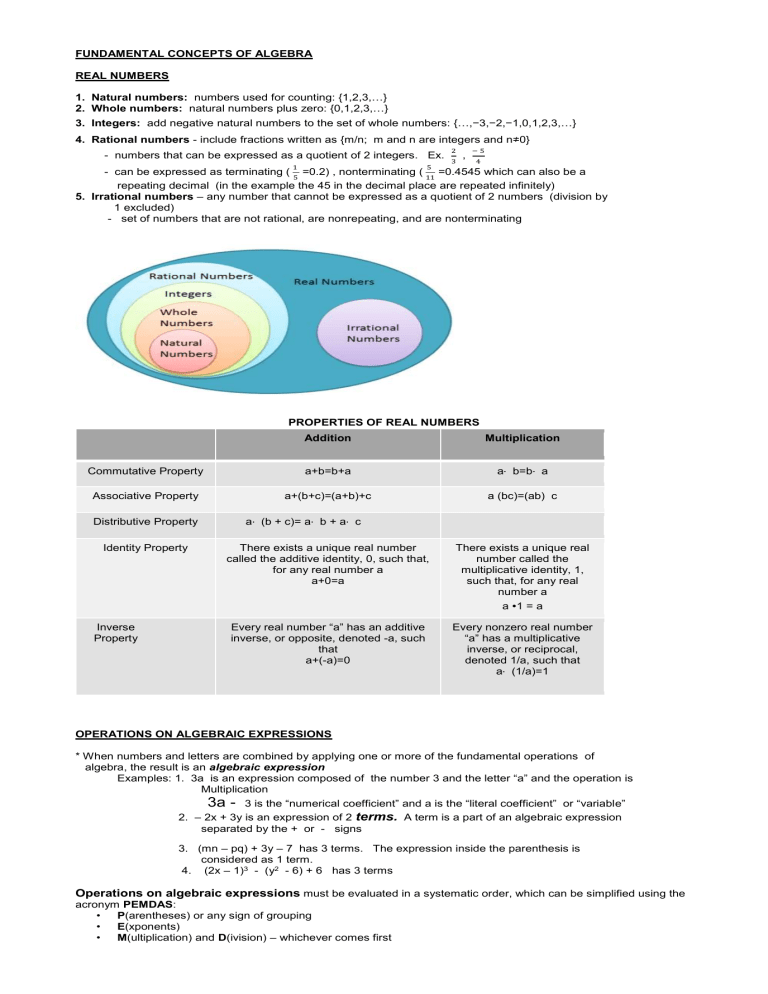
FUNDAMENTAL CONCEPTS OF ALGEBRA
REAL NUMBERS
1. Natural numbers: numbers used for counting: {1,2,3,…}
2. Whole numbers: natural numbers plus zero: {0,1,2,3,…}
3. Integers: add negative natural numbers to the set of whole numbers: {…,−3,−2,−1,0,1,2,3,…}
4. Rational numbers - include fractions written as {m/n; m and n are integers and n≠0}
- numbers that can be expressed as a quotient of 2 integers. Ex.
1
5
2
3
,
−5
4
- can be expressed as terminating ( =0.2) , nonterminating ( =0.4545 which can also be a
5
11
repeating decimal (in the example the 45 in the decimal place are repeated infinitely)
5. Irrational numbers – any number that cannot be expressed as a quotient of 2 numbers (division by
1 excluded)
- set of numbers that are not rational, are nonrepeating, and are nonterminating
PROPERTIES OF REAL NUMBERS
Addition
Multiplication
Commutative Property
a+b=b+a
a⋅ b=b⋅ a
Associative Property
a+(b+c)=(a+b)+c
a (bc)=(ab) c
a⋅ (b + c)= a⋅ b + a⋅ c
Distributive Property
Identity Property
There exists a unique real number
called the additive identity, 0, such that,
for any real number a
a+0=a
There exists a unique real
number called the
multiplicative identity, 1,
such that, for any real
number a
a ∙1 = a
Inverse
Property
Every real number “a” has an additive
inverse, or opposite, denoted -a, such
that
a+(-a)=0
Every nonzero real number
“a” has a multiplicative
inverse, or reciprocal,
denoted 1/a, such that
a⋅ (1/a)=1
OPERATIONS ON ALGEBRAIC EXPRESSIONS
* When numbers and letters are combined by applying one or more of the fundamental operations of
algebra, the result is an algebraic expression
Examples: 1. 3a is an expression composed of the number 3 and the letter “a” and the operation is
Multiplication
3a -
3 is the “numerical coefficient” and a is the “literal coefficient” or “variable”
2. – 2x + 3y is an expression of 2 terms. A term is a part of an algebraic expression
separated by the + or - signs
3. (mn – pq) + 3y – 7 has 3 terms. The expression inside the parenthesis is
considered as 1 term.
4. (2x – 1)3 - (y2 - 6) + 6 has 3 terms
Operations on algebraic expressions must be evaluated in a systematic order, which can be simplified using the
acronym PEMDAS:
• P(arentheses) or any sign of grouping
• E(xponents)
• M(ultiplication) and D(ivision) – whichever comes first
•
A(ddition) and S(ubtraction) – whichever comes first
How to simplify expression using the Order of Operations:
1. Simplify any expressions within grouping symbols and appropriately remove the signs of groupings (removing
signs of grouping must be done from the innermost to the outermost pairs of signs of groupings).
2. Simplify any expressions containing exponents or radicals
3. Perform any multiplication and division in order, from left to right
4. Perform any addition and subtraction in order, from left to right
● Only similar terms can be combined by addition or subtraction. Similar terms are terms with the
1
same literal coefficient. (3x and -7x are similar terms; 2x2y , x2y and x2y are similar terms.
4
EXAMPLES. Remove signs of grouping and
combine like terms
1. 6 ÷ 3 ⋇ 2 = 4
2. 2x – 3y(x – 2y) – (6x – 4y)
= 2x – 3xy + 6y2 – 6x + 4y
= - 4x + 4y – 3xy +6y2
3. 2x – [-2(x + y) + 3(3x -2y)]
= 2x – [-2x – 2y + 9x – 6y]
= 2x – [7x – 8y]
= 2x - 7x + 8y
= - 5x + 8y
4. 2{3x + 4[2x - (4 – x) – 3(4x – 3y)]}
= 2{3x + 4[-9x + 9y -4]}
= 2{3x - 36x +36y -16}
= 2{-33x + 36y – 16}
= -66x + 72y – 32

